Forgiving My Religion
What follows is my sermon from Sunday, April 28, 2013: Native American Ministries Sunday, when we were joined by the Thunderbird American Indian Dancers. Several folks asked for copies of my words, so here is a copy for all.
For those who have been in one of our Church of the Village Exploring Faith Classes, this will all be review! For anyone who doesn’t know, Exploring Faith Classes are for people who are new to the church or who haven’t yet become members. (And we’ll have another class coming up pretty soon!)
One thing we talk about in the class is Progressive Christianity and how to read the Bible in a progressive way. And we discuss how, in recent history, when Christians have tried to understand God and the Bible, they have look to the “authorities”, i.e. academics in universities. And this is not in and of itself a bad thing.
I happen to love academics and universities! I went to college at a very “academic” institution: The University of Chicago, where we sold sarcastic t-shirts that said, “U of C: Where fun comes to die.” “U of C: Where the squirrels are cuter than the girls.” “U of C: Where the squirrels are more aggressive than the guys.” Or—and I just heard this one recently (It’s also kind of mean.)—“U of C: Where half the student body looks like Woody Allen, and the guys are ugly, too.”
There are lots of others, but they aren’t as easy or appropriate to share in church—mostly they are theoretical calculus formulas that prove how little sex U of C students have and other such nerd humor.
Anyways—all that to say that I loved my academic/university experience. I am a very out nerd who loves “The Life of the Mind”, which was the officially sanctioned slogan of my school. So I do believe it is a really good thing to listen to and read what scholars say about the Bible and God!
But the problem is that, for several hundred years, the only people who became scholars of God and Bible were European men, mostly from the middle or upper class.
And, while it is really important to know what European men from the middle or upper class think about God and Bible, there are so so many other perspectives and ways of talking about God and Bible! And we need to hear from all of those perspectives because God speaks to and through all of us, and we learn from each other.
So that’s a big part of reading the Bible in a progressive way. We read with people from all different backgrounds and life experiences.
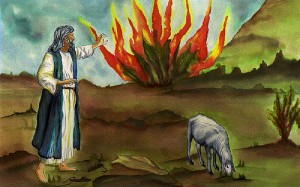 So, in our Exploring Faith class, we always read Exodus 3 with people from different backgrounds and life experiences. Exodus 3 begins with Moses helping out his father-in-law by babysitting his sheep. So Moses and the sheep are just outside somewhere minding their own business, when all of a sudden—and doesn’t this always happen when you’re trying to just have a chill day with the sheep—a bush bursts into flame next to him! And he hears a voice in the bush. And, of course, it’s God talking to him from a bush that’s on fire. Been there, right?
So, in our Exploring Faith class, we always read Exodus 3 with people from different backgrounds and life experiences. Exodus 3 begins with Moses helping out his father-in-law by babysitting his sheep. So Moses and the sheep are just outside somewhere minding their own business, when all of a sudden—and doesn’t this always happen when you’re trying to just have a chill day with the sheep—a bush bursts into flame next to him! And he hears a voice in the bush. And, of course, it’s God talking to him from a bush that’s on fire. Been there, right?
So Moses starts chatting away with this campfire of a bush. And God says, “I have heard my people crying out to me, and I’ve seen them suffering in slavery in Egypt, and I’m about to go on down there and liberate them! And I’m going to bring them out of that horrible slavery, and I’m going to bring them to good and broad land, a land flowing with milk and honey, to the land of the Canaanites, the Hittites, the Amorites, the Perizzites, the Hivites, and the Jebusites. And you’re going to help me, Moses!”
And the rest is history—Moses goes to Pharoah, there are frogs and flies and boils and blood on doors and an angel of death! Then the sea parts, and, yadda yadda yadda, 40 years later, God’s people come into the promised land like rock stars! So that’s basically the book of Exodus!
In the class, we talk about how people from different experiences might read that story. First, we think about an African American experience. The Black Church tradition often relates to the experience of the Israelites being slaves in Egypt. So, when God brings the Israelites out of slavery in Egypt, God brings African Americans out of slavery and Jim Crow in the United States. And the promised land is our nation living up to its promises of liberty and equality for all people.
Then we look at this story from the perspective of folks who are lesbian, gay, bisexual, or transgender. There is actually a field of study called Queer Theology, and scholars from the LGBT community talk a lot about the coming out experience—when you reveal to the folks around you who you really are. So one might think of this burning bush incident as a God’s coming out experience. Before this moment, slavery and oppression has all been going on, and God has basically been silent about it. But here is a moment when God goes to Moses and reveals to a friend who God really is—a God who sees her peoples’ suffering, a God of liberation and justice, a God who will take care of his people and allow them to flourish in a good land. So, from an LGBT reading, this could be God’s coming out experience!
Now, you all might have your own personal reading of this story, but isn’t it enriching to hear how people from different experiences read the story? The more people we read the Bible with, the closer and closer we get to its many truths. It is very cool!
But it can also be challenging to hear other perspectives.
Now we come to ask how someone might read this story from the Native American experience. And this is where it gets uncomfortable. Because when many indigenous people read this passage, they do not relate to the experience of being liberated from slavery into a promised land. They do not see themselves in Moses or the Israelites. Instead, they see themselves in the Canaanites, the Hittites, the Amorites, the Perizzites, the Hivites, and the Jebusites. The people who were in the promised land before it was promised to someone else.
Now, without this perspective of indigenous people, many of us might have just unquestioningly gone along with this story, rooting for those Israelite protagonists, as they are liberated from oppression into a land flowing with milk and honey.
Without the indigenous perspective, we could have blindly seen the land of the Canaanites as Canaanite land instead of a land containing a Canaanite civilization of Canaanite human beings. We could have forgotten about the hearts that beat within those Canaanites. We could have forgotten the sacred lives and longings of the Hittites, the fields tilled and harvested with Amorite hard work and humility, the tender love between Perizzite children and their mothers and fathers, the human grief and gratitude of Hivites as they buried their dead, the ways the Jebusites built community and sought the transcendent. We could have forgotten all of these children of God who were discovered and displaced and devalued and destroyed so that others could inherit their land of promise.
Without the indigenous perspective, we could have forgotten about the ways empires and formerly oppressed people have come into new lands and used this passage to displace, devalue, and destroy the Canaanites of every age, including the Native people of this continent that we call our home and promised land. Without the indigenous perspective, we could forget that those empires and formerly oppressed people used this very story of the Exodus, used the name of the very same God—the name of our God—to justify their avaricious atrocities and ignorant injustices.
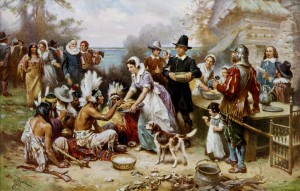 Last week, in our Wednesday morning prayer call and in my blog, I talked about growing up and out of the fruit loop necklaces and construction paper feather hats of our childhood Thanksgiving myths. Most of us have had those moments of disillusionment with our nation when we had to stuff the Thanksgiving myth right next to Santa Claus in the age appropriate bins of our attics. Because at some age, we learn the truth, that the real story of the European settlers and the indigenous people of this land contained far fewer happy meals and far more broken treaties, massacres, exiles, and denigrations of indigenous cultures.
Last week, in our Wednesday morning prayer call and in my blog, I talked about growing up and out of the fruit loop necklaces and construction paper feather hats of our childhood Thanksgiving myths. Most of us have had those moments of disillusionment with our nation when we had to stuff the Thanksgiving myth right next to Santa Claus in the age appropriate bins of our attics. Because at some age, we learn the truth, that the real story of the European settlers and the indigenous people of this land contained far fewer happy meals and far more broken treaties, massacres, exiles, and denigrations of indigenous cultures.
And learning those kinds of truths appropriately makes us lose some faith in our government and in the people around us. And that’s ok and good—because our government and the people around us are capable of both great good and great evil, and that’s just a hard truth we need to know as thinking adults in this world.
The same thing happens with the church. A lot of us grow up and put the church right next to our national Thanksgiving myth and Santa Claus in that same age appropriate bin in the attic. Because we grow up with this myth that the church and the church’s people are perfect representatives of God. This is the reign of God on Earth! We know the secrets of salvation, and the people who do not know what we know and who do not do what we do are doomed!
But, at some point in our growing up, we realize that the church and its people are just like everyone else. Sinful—capable of good and capable of evil. That realization comes in many ways. For some of us, it’s the sexual abuse cover-ups or the way the church told us to stay in unhealthy relationships. For some of us, it’s the way we were taught that science and religion don’t mix, and we just couldn’t avoid the modern world anymore. For some of us, we realized we were gay, and the church threatened our destruction. For some of us, it’s just that we realized that there were people outside the church who seemed far more spiritual, moral, and loving than anyone we ever met in church.
And so we fold the church up and place it in the bin with Santa Claus.
For me, the thing that almost landed the church in my age-appropriate attic bin, was the way Christianity has treated indigenous people and cultures around the world. The way empires and white settlers walked hand in hand with missionaries and church structures for the purposes of national conquest and riches. The way indigenous people have been given the “choice” between worshipping the European Jesus and poverty, death, and displacement.
In case there is anyone here who does not know the role of the church and Christian people in the displacement and destruction of Native people and traditions in this country, I will give one important example. It is a story that every Methodist should know.
The place was Sand Creek, Colorado. The year was 1864, when Colorado soldiers, unprovoked, attacked a Cheyenne settlement, proceeded to massacre over 150 innocent people, mostly women, children, and elders, and then mutilated their bodies.
The attack was approved by Governor John Evans, a nationally known Methodist who helped to found two Methodist Universities. The attack was led by the Rev. John Chivington, a Methodist pastor and former District Superintendent, which is the second highest clergy office in our church.
So, if you are to be a Methodist, you must know the name of The Sand Creek Massacre. Because one of the most devastating unprovoked attacks on Native people by the U.S. government was led by a decorated Methodist pastor and approved by a prominent Methodist layman. And I believe that if we are going to celebrate the heroic things our Methodist ancestors did, we must also own the evil that our Methodists ancestors have done—the way our people have hurt other people.
Otherwise, more and more young people will take this simplistic and childish fairy tale we call our religion and store it in their attics with the other lies they have been told. And, most importantly, if we do not tell these stories, we will commit the same sin over and over again.
Last year, at the international United Methodist gathering called General Conference, one night of worship was devoted to an Act of Repentance, when international church leaders gathered with indigenous folks from around the world, and we confessed our stories of horror, and we committed together to change and make things different.
The preacher that night was a Native American scholar named George Tinker, and he reminded us that, after our nation finished conquering the lands of this nation, we moved on to other lands. He reminded us that it was President William McKinley, a staunch Methodist, who led the efforts to colonize the Philippines in 1899. George Tinker told us that, at one point, President McKinley got down on his knees in front of a group of missionaries and told them how he longed to bring the indigenous Filipino people to Christ. He accomplished that mission in the Philippine-American war, which led to the massacre of up to 1 million indigenous Filipinos. If we do not tell these stories, we will commit the same sin over and over again.
Now, in drudging up all of this history, we are not just trying to ruin Thanksgiving and put a frown on everyone’s faces. We are calling for our nation and for our churches to take a look in the mirror, to see the way we treat vulnerable people inside our walls and out. Because, just like the Exodus story, these are not just stories from the past. These are powerful, living stories that are repeated over and over again. Repeated in the way we treat all people of color, including Native people and immigrants in this nation. Repeated in the way the church treats LGBT people and the poor. Repeated in the way our country and churches continue to engage internationally. The Canaanites are hurt over and over again.
Now, I know this is still the Easter season, and I need to get to the resurrection and joy and good news! So here is one piece of good news. We have a choice about these stories. We can take a hard look in the mirror and discern God’s spirit moving in the world, calling us to repent for the parts of our story that have hurt God’s children, calling us to reexamine what is truly sacred about our story.
We have a choice of whether or not to continue believing in a God who desires to conquer oppressed people. Or we could listen to the overwhelming message of the entire Bible and begin to believe in a God who liberates the oppressed and desires justice for the oppressors.
Now, my sermon title today is called “Forgiving My Religion”. (Or, as Faser and Mark shared with me on Sunday, in the South it would rhyme: “Forgivin’ My Religion”!)
I wanted to tell you how I forgave my religion. I wanted to tell you why I did not end up folding up my Christian faith and storing it in my attic. When I was a college student, I had the opportunity to study abroad, and I chose to go to India because I wanted to find the truth about how Western empires held hands with the church while they hurt indigenous people. And India was one of the many places where that happened.
So I went to India, and, while I was in India, I looked for a church where I could just worship myself for my three months there. And I had all these feelings about going to church in India. Because I knew that many of the churches established in India had come hand in hand with Empire. I ended up at an English speaking church, that was full of American praise music and evangelical practices. And a part of that sickened me.
But that church took me in to their community, and over those few months, we shared meals together, we shared life. I heard them take traditional Indian ragas and sing them to Jesus. And I came to see that, in spite of how I felt about the way that church started, it was now a sacred community. The people there were God’s people. They found liberation and comfort in their Christian faith. They did good in the world and brought a new perspective to both their culture and to the church.
And over those months, I was gradually able to forgive my religion. (Besides, seeing that other religions were just as crazy and messed up as ours is!) I saw that, what humans had meant for evil, God had turned into good. When the church held hand with the evil of empire, God’s goodness would not be coopted by imperialist greed and ignorance. God turned around the sin and evil of the church’s friendship with empire and created beauty and goodness and true community.
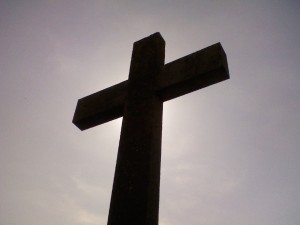 That is what God does. That is the Easter message—that if God can turn a device used for torture and death and empire into a symbol of resurrection and life, God can turn anything around for good.
That is what God does. That is the Easter message—that if God can turn a device used for torture and death and empire into a symbol of resurrection and life, God can turn anything around for good.
God’s goodness is like those little sprouts of grass that will themselves up through the tiny cracks in the sidewalk, unwilling to be conquered. To quote Jurassic Park, “Life always finds a way!” God finds a way. Good finds a way. Love and justice and reconciliation find a way through the inherent weaknesses of the concrete jungles of sin and evil that try to stifle them and kill them and uproot them and displace them.
It is true in our lives, and it is true in the life of the church around the world—including our own—that may have been founded on the backs of imperial expansion but is now and can be from now on a seed of reconciliation and justice.
That is what God is up to today among us—bringing together, perhaps awkwardly at times, the church with the Native traditions it once feared and hurt. Bringing us together to appreciate and learn from each other’s sacred traditions so that we might come to a place of repentance and reconciliation and healing and justice.
Thanks be to God! Amen.
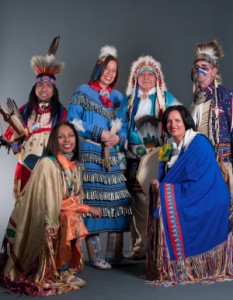
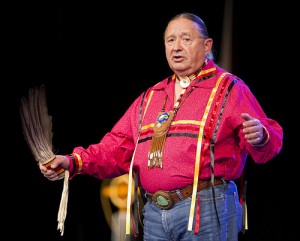

Thanks Vicki. And from David and Bathsheba came Solomon . . . and Jesus the Christ. God takes our evil and weaves it into his triumphant purposes. Not to condone the evil but to assert his sovereignty over it. The story also, of course, of the Cross and Resurrection. Not quite a maytter of forgving our religion but seeing — thankfully — that God is not limited by it.
[…] On Sunday, we had Native American dancers share their sacred movements in front of the altar of the church—a church that used to fear and destroy such non-European cultural displays. And, although it may have felt unfamiliar and possibly even uncomfortable to both our church and the dancers, it was probably the most traditional thing we could have done in a church that began with the awkward reconciliation between hostile groups in Christ’s biracial body. […]